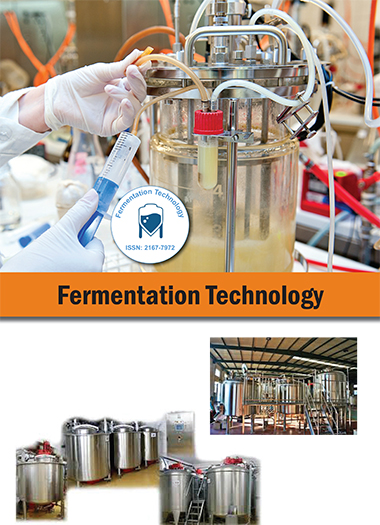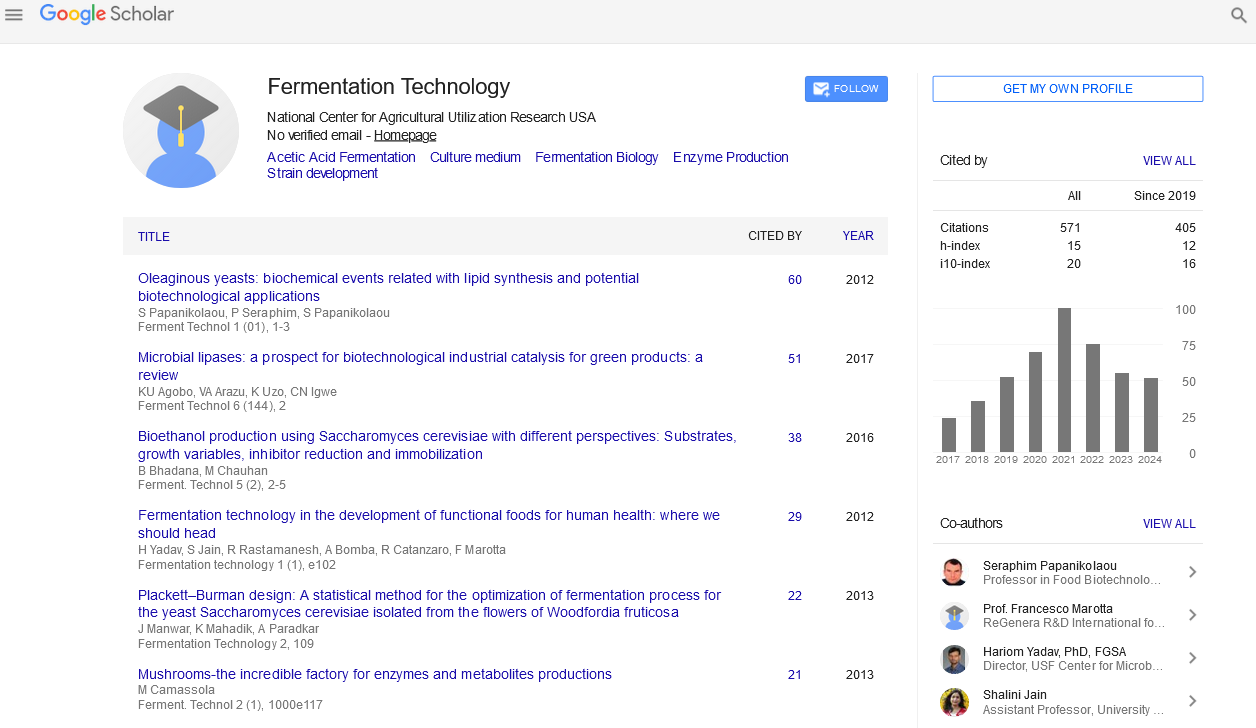Indexed In
- Open J Gate
- Genamics JournalSeek
- Access to Global Online Research in Agriculture (AGORA)
- RefSeek
- Hamdard University
- EBSCO A-Z
- OCLC- WorldCat
- Publons
Useful Links
Share This Page
Journal Flyer

Open Access Journals
- Agri and Aquaculture
- Biochemistry
- Bioinformatics & Systems Biology
- Business & Management
- Chemistry
- Clinical Sciences
- Engineering
- Food & Nutrition
- General Science
- Genetics & Molecular Biology
- Immunology & Microbiology
- Medical Sciences
- Neuroscience & Psychology
- Nursing & Health Care
- Pharmaceutical Sciences
Short Communication - (2023) Volume 12, Issue 1
Advantages, Disadvantages and Applications of Fed Batch Fermentation
Sara Lopez*Received: 03-Mar-2023, Manuscript No. FMT-23-20067; Editor assigned: 06-Mar-2023, Pre QC No. FMT-23-20067(PQ); Reviewed: 21-Mar-2023, QC No. FMT-23-20067; Revised: 28-Mar-2023, Manuscript No. FMT-23-20067(R); Published: 07-Apr-2023, DOI: 10.4172/2167-7972.23.12.161
Description
It is a modification to the batch fermentation. The process adds substrate periodically as the fermentation progresses to ensure that the substrate is always present at the optimum concentration. This is important as some secondary metabolites undergo catabolic repression by high concentrations of glucose or other carbohydrates or nitrogen compounds present in the medium [1-3].
For this reason, the key elements of the nutrient medium are added in small amounts at the start of fermentation and these substrates continue to be added in small amounts during the production phase. This process is commonly used to manufacture substances such as penicillin. Yoshida (1973) first introduced the term to keep nutrients at optimal levels by adding substrates to the medium when nutrients are depleted [4,5].
Fed-batch fermentation has three types
Variable volume fed-batch culture: Adding the same medium will increase the volume.
Fixed-volume fed-batch culture: A very small volume of a highly concentrated solution of containment substrate is added, resulting in a slight increase in medium volume.
Circulating fed-batch culture: Since the substrate concentration during fermentation cannot be measured by direct methods, indirect methods are usually used. For example, in organic acid production, pH can be used to determine glucose availability.
Advantages
• Generation of high cell densities (especially growth-related products) by increasing working time.
• Controlled conditions in providing substrate during fermentation of carbon source.
• Suppression of by-product formation or catabolites, controlling the effects of limited substrate supply required only for product formation.
• Modes of operation can overcome and control deviations in organismal growth patterns seen in batch fermentation.
• Moisture loss can be replaced by evaporation.
• Alternate modes of operation for fermentation with toxic or sparingly soluble compounds.
• Enhance the stability of antibiotic-tagged plasmids by producing corresponding antibiotics during fermentation.
• No additional special equipment is required compared to batch fermentation.
• An effective method of producing certain chemicals, such as penicillin, that are produced at optimal levels when the medium is depleted.
Disadvantages
• It is not possible to measure the concentration of feed substrates by direct methods such as chromatography.
• Valuable analysis of microorganisms is required. An understanding of its requirements and the physiology that accompanies productivity is essential.
• Setting up the fermentation and developing the process requires a significant amount of operator skill.
• In cycles of fed-batch culture, care must be taken in designing the process so that toxins do not accumulate to inhibitory levels, and when many cycles are run, nutrients other than those incorporated into the fed-batch medium are also introduced. Limited Accumulation of non-producing or lowproducing variants may occur.
• The amount of the component to be controlled should exceed the detection limit of available measurement equipment.
Cell Recycle Fed-Batch can also be used for special applications such as ethanol fermentation and wastewater treatment.
The following products are currently produced in fed-batch culture.
• Production of baker's yeast
• Penicillin production
• Production of thiostrepton by Streptomyces laurentii
• Production of industrial enzymes, histidine, glutathione, lysine
Applications
• Facilitates avoidance of oppressive effects.
• Controls the growth rate and oxygen requirements of organisms.
• By keeping the concentrations of both biomass and unconstrained growth medium constant.
• The production phase can be extended under controlled conditions to overcome problems associated with the use of inhibitory and rapidly metabolized substrates.
• Growth rate shifts may offer opportunities for optimal product synthesis.
• Helps overcome viscosity issues and toxicity at high concentrations.
References
- Delvigne F, Lecomte JP. Foam formation and control in bioreactors. Encyclopedia of Industrial Biotechnology. 2009;1-3.
- Deutscher J. The mechanisms of carbon catabolite repression in bacteria. Curr Opin Microbiol.2008;11(2):87-93.
[Crossref] [Google Scholar] [PubMed]
- Fic E, Bonarek P, Górecki A, Kedracka-Krok S, Mikolajczak J, Polit A et.al;. cAMP receptor protein from Escherichia coli as a model of signal transduction in proteins–a review J Mol Microbiol Biotechnol. 2009;17(1):1-11.
[Crossref] [Google Scholar] [PubMed]
- Isaacs Jr H, Chao D, Yanofsky C, Saier Jr MH. Mechanism of catabolite repression of tryptophanase synthesis in Escherichia coli. Microbiology. 1994;140(8):2125-2134.
[Crossref] [Google Scholar] [PubMed]
- Liu Q, Luo G, Zhou XR, Chen GQ. Biosynthesis of poly (3-hydroxydecanoate) and 3-hydroxydodecanoate dominating polyhydroxyalkanoates by β-oxidation pathway inhibited Pseudomonas putida. Metab Eng.2011;13(1):11-17.
Citation: Lopez S (2023) Advantages, Disadvantages and Applications of Fed Batch Fermentation. Ferment Technol. 12:161.
Copyright: © 2023 Lopez S. This is an open-access article distributed under the terms of the Creative Commons Attribution License, which permits unrestricted use, distribution, and reproduction in any medium, provided the original author and source are credited.

